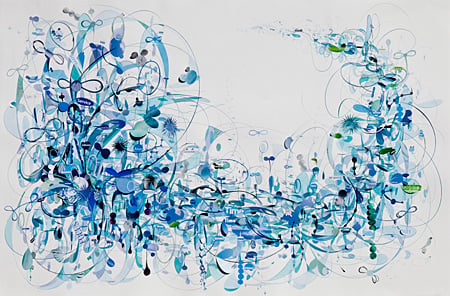
Aurora Robson is a New York-based artist whose work is focused on turning the negative into a positive through awareness and activism. Robson repurposes plastic waste into vibrant sculptures, and uses paper packaging and junk mail for her dream-like collage paintings.
Aurora Robson, Scrutiny on the Bounty (triptych), from The Big Show exhibition, 2013, Silas Marder Gallery, Bridgehampton, NY
Jenn Cortés: What are you trying to communicate with your art?
Aurora Robson: My goal is to employ art as a device for shifting values. As opposed to merely communicating, I am attempting to literally reprogram myself and my audience in terms of our relationship to matter, ourselves, and each other. Every moment I have to practice in my studio is a gift, so I express love and gratitude through my work, focusing on shifting negative trajectories into more positive directions. Transformation, through human energy and consciousness, is essential to my practice. I believe that everything is contagious: I try to infect people with a heightened sense of appreciation. While deeply personal, my work is also a global meditation.
JC: Describe your creative process. What kind of creative patterns, routines, or rituals do you have?
AR: My dedication to intercepting the waste stream as a part of my practice has made it such that my process includes first, establishing a clean, organized, brightly lit, positively charged work space. I want my work to be an accurate reflection of reality, but waste is messy. I aim for precision in the work. In order to achieve that precision, my studio must be carefully prepared. I listen to news and information on various programs for a portion of the day so that I can stay informed. Then for the remainder of the day, I typically play energetic or meditative, innovative music to aid in processing information and maintaining creative momentum.
JC: Do you ever experience artist’s block? If so, what do you do to overcome it?
AR: I keep my favorite Chuck Close (American, b.1940) quote pasted up in my studio: “Inspiration is for amateurs, the rest of us show up.” It helps keep me focused. I think that having had to hold other jobs for so long prior to becoming a full-time artist has given me a great deal of appreciation for the life I have now, so much so that I don’t dwell in the luxurious real estate of a “block” of any kind for very long. To me, being depressed or inactive would be too easy; therefore, I would lose respect for myself if I permitted myself to be blocked. I usually choose the road that isn’t a road yet—that in and of itself is like a block, but a porous block, and mobility and flexibility are keys to getting through any kind of obstacle, be it mental, physical, or spiritual. I try to be like water.
JC: When is your next exhibition? Why should we come?
AR: I have an exhibit called Circumdare opening at the new Southampton Center on August 10. In it will be a substantial number of my suspended sculptures, wall reliefs, paintings, and collages. It will feature work with junk mail, excess packaging, and plastic debris. There will be other artists who make great work floating around too. Everyone should come!
Aurora Robson, The Great Indoors, 2008, 15,000 PET bottles, tinted polycrylic, solar-powered LEDs, Rice Gallery, Leawood, KS
JC: Has the Internet dramatically changed the dynamic of your business?
AR: My work is labor intensive, so without the Internet, promoting my work would be completely shouldered by the few galleries that have supported me thus far. The Internet has made it possible for me to afford to be an artist and have a family. I would be completely trapped in obscurity without it. I launched my own website the moment I began practicing full time. It has been the easiest way to introduce people to my work around the world. It has provided me with a diverse audience, a growing collector base, a great deal of publicity, and an effective platform for communicating my ideas. I love the Internet.
JC: Would you recommend any particular type of training, courses, programs, or books to people interested in becoming an artist?
AR: I recommend developing as many skills as possible before launching into a full-time practice: your work will likely demand much of you. The more self-sufficient and skilled you can be, the better you will be able to survive and prosper. I also recommend traveling the world, experiencing art and culture as much as you can. This way, once you engage in a serious studio practice, you will be creating work with awareness and wisdom embedded in it. Reading about art history and critical discourse will also help you find your bearings.
Aurora Robson, Minimum Down, from Sacrifice + Bliss series, 2012, junk mail collage, Franklin Park Conservatory, Columbus, OH
JC: Do you collect art yourself? If so, tell us about your collection.
AR: I have built a substantial collection almost exclusively through trading with other Contemporary artists. I gravitate toward work that is minimal and has more restraint than I typically apply in my own work. I like art that is executed with skill, care, poetry, grace, reflection, and humor, but not ambivalence or irony. I also have some work (in addition to trades) that has come to me as gifts that I really love. Knowing the artists gives the work greater resonance and deeply fuels my desire to financially support other artists in addition to trading with them.